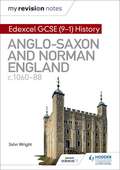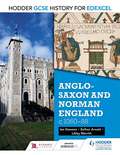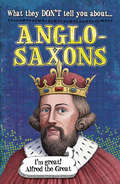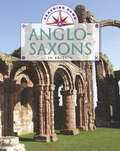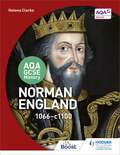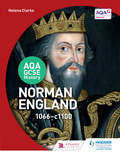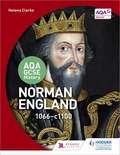Special Collections
Saxons and Vikings
Description: Books and images for project and them based learning about Saxons and Vikings
- Table View
- List View
An Anglo-Norman Reader
by Jane BlissThis book is an anthology with a difference. It presents a distinctive variety of Anglo-Norman works, beginning in the twelfth century and ending in the nineteenth, covering a broad range of genres and writers, introduced in a lively and thought-provoking way. Facing-page translations, into accessible and engaging modern English, are provided throughout, bringing these texts to life for a contemporary audience. The collection offers a selection of fascinating passages, and whole texts, many of which are not anthologised or translated anywhere else. It explores little-known byways of Arthurian legend and stories of real-life crime and punishment; women’s voices tell history, write letters, berate pagans; advice is offered on how to win friends and influence people, how to cure people’s ailments and how to keep clear of the law; and stories from the Bible are retold with commentary, together with guidance on prayer and confession. Each text is introduced and elucidated with notes and full references, and the material is divided into three main sections: Story (a variety of narrative forms), Miscellany (including letters, law and medicine, and other non-fiction), and Religious (saints' lives, sermons, Bible commentary, and prayers). Passages in one genre have been chosen so as to reflect themes or stories that appear in another, so that the book can be enjoyed as a collection or used as a resource to dip into for selected texts. This anthology is essential reading for students and scholars of Anglo-Norman and medieval literature and culture. Wide-ranging and fully referenced, it can be used as a springboard for further study or relished in its own right by readers interested to discover Anglo-Norman literature that was written to amuse, instruct, entertain, or admonish medieval audiences.
Anglo-saxon And Norman England, C.1060-88 (My Revision Notes Edexcel GCSE (9-1) History) (PDF)
by John WrightExam Board: Edexcel Level: GCSE Subject: History First Teaching: September 2016 First Exam: Summer 2018 Endorsed for Edexcel Target success in Edexcel GCSE (9-1) History with this proven formula for effective, structured revision; key content coverage is combined with exam-style questions, revision tasks and practical tips to create a revision guide that students can rely on to review, strengthen and test their knowledge. With My Revision Notes, every student can: - Plan and manage a successful revision programme using the topic-by-topic planner - Enjoy an interactive approach to revision, with clear topic summaries that consolidate knowledge and related activities that put the content into context - Build, practise and enhance exam skills by progressing through activities set at different levels - Improve exam technique through exam-style questions and model answers with commentary from expert authors and teachers - Get exam ready with extra quick quizzes and answers to the activities available online
Anglo-saxon And Norman England, C.1060-88 (PDF)
by Esther Arnott and Libby Merritt and Ian DawsonEndorsed for Edexcel Help your students achieve their full potential while ensuring pace, enjoyment and motivation with this unique series from the leading History publisher; developed by expert educators who know how to instil deep subject knowledge and an appetite for lifelong learning. - Provides distinct approaches to the different components of the 2016 specification, ensuring that your classroom resources are tailored to learners' changing needs as they progress through the curriculum - Caters for varying learning styles, using an exciting mix of clear narrative, visual stimulus materials and a rich collection of contemporary sources to capture the interest of all students - Helps students maximise their grade potential and develop their exam skills through structured guidance on answering every question type successfully - Blends in-depth coverage of topics with activities and strategies to help students acquire, retain and revise core subject knowledge across the years - Builds on our experience publishing popular GCSE resources to supply you with accurate, authoritative content written by experienced teachers who understand the practical implications of new content and assessment requirements Anglo-Saxon and Norman England, c. 1066-88 covers all three key topics in the specification: 'Anglo-Saxon England and the Norman Conquest, 1060-66'; 'William in power: securing the kingdom, 1066-87'; 'Norman England, 1066-88. '
The Anglo-Saxon Chronicle
by James IngramOriginally compiled on the orders of King Alfred the Great, approximately A.D. 890, and subsequently maintained and added to by generations of anonymous scribes until the middle of the 12th Century.
Anglo-Saxon framed building (large print)
by RnibThis page shows two labelled views of a typical Saxon building and the different materials that were used in its construction. There is a locator dot shown, which will be at the top left of the page when the image is the right way up. At the top of the page is a side view of the building with a steep roof coming to a point at the top. Further down the page is a window opening. In the bottom part of the page there is a front view of the building with the facing of the roof and further down, in the centre, is the entrance.
Anglo-Saxon framed building (Large Print)
by RnibThis page shows two labelled views of a typical Saxon building and the different materials that were used in its construction. There is a locator dot shown, which will be at the top left of the page when the image is the right way up.At the top of the page is a side view of the building with a steep roof coming to a point at the top. Further down the page is a window opening. In the bottom part of the page there is a front view of the building with the facing of the roof and further down, in the centre, is the entrance.
Anglo-Saxon framed building (UEB Contracted)
by RnibThis page shows two labelled views of a typical Saxon building and the different materials that were used in its construction. There is a locator dot shown, which will be at the top left of the page when the image is the right way up.At the top of the page is a side view of the building with a steep roof coming to a point at the top. Further down the page is a window opening. In the bottom part of the page there is a front view of the building with the facing of the roof and further down, in the centre, is the entrance.
Anglo-Saxon framed building (UEB uncontracted)
by RnibThis page shows two labelled views of a typical Saxon building and the different materials that were used in its construction. There is a locator dot shown, which will be at the top left of the page when the image is the right way up. At the top of the page is a side view of the building with a steep roof coming to a point at the top. Further down the page is a window opening. In the bottom part of the page there is a front view of the building with the facing of the roof and further down, in the centre, is the entrance.
Anglo-Saxon framed building (UEB Uncontracted)
by RnibThis page shows two labelled views of a typical Saxon building and the different materials that were used in its construction. There is a locator dot shown, which will be at the top left of the page when the image is the right way up.At the top of the page is a side view of the building with a steep roof coming to a point at the top. Further down the page is a window opening. In the bottom part of the page there is a front view of the building with the facing of the roof and further down, in the centre, is the entrance.
Anglo-Saxons
by Robert FowkeThe Saxons weren't the first newcomers to the islands of Britain, and they certainly weren't the last, but they changed Britain more than any other group of people before or after them.Start right at the beginning and learn who the Saxons were and how they became known as the Anglo-Saxons. From the Dark Ages to the Venerable Bede, the Anglo-Saxon Chronicle and Beowulf, find out how we know what we know about the Anglo Saxons. Read about Saxon kings, laws and punishments; how language and place names evolved; everyday life from houses, farming and working life, paganism and Christianity; how Anglo Saxons have influenced life today, from place names to days of the week; how the Vikings attacked and about King Alfred and his attempts to repel them; and how Saxon life came to an end with an arrow in the eye for Harold Godwine at the Battle of Hastings which led to our first Norman king, William the Conqueror.
The Anglo-Saxons in Britain
by Moira Burretfield'The past is all around us, if we know where to look.' This series takes a look at archaeological, structural and museum evidence from around Britain, allowing readers to build up a picture of what life was like in key historical periods and how you can discover it for yourself by visiting sites around the country.
Anglo-Saxon thane (large print)
by RnibThis page shows an Anglo-Saxon thane: a man holding lands from the king, or a Lord of the Manor. There is a locator dot shown, which will be at the top left of the page when the image is the right way up.The thane stands facing you wearing a long cloak with a hood. Under this, he wears a long belted tunic and jewellery around his waist and on his chest. His arms are held out to the right and left and his feet, wearing slippers, are at the bottom of the page.
Anglo-Saxon thane (UEB contracted)
by RnibThis page shows an Anglo-Saxon thane: a man holding lands from the king, or a Lord of the Manor. There is a locator dot shown, which will be at the top left of the page when the image is the right way up.The thane stands facing you wearing a long cloak with a hood. Under this, he wears a long belted tunic and jewellery around his waist and on his chest. His arms are held out to the right and left and his feet, wearing slippers, are at the bottom of the page.
Anglo-Saxon thane (UEB uncontracted)
by RnibThis page shows an Anglo-Saxon thane: a man holding lands from the king, or a Lord of the Manor. There is a locator dot shown, which will be at the top left of the page when the image is the right way up.The thane stands facing you wearing a long cloak with a hood. Under this, he wears a long belted tunic and jewellery around his waist and on his chest. His arms are held out to the right and left and his feet, wearing slippers, are at the bottom of the page.
Anglo-Saxon warrior (large print)
by RnibThis page shows an Anglo-Saxon warrior dressed and equipped for battle. There is a locator dot shown, which will be at the top left of the page when the image is the right way up. The warrior is standing facing you and is wearing a metal helmet, a cloak and a chain mail tunic. He holds a spear in his hand to the left and a wooden shield to the right. He wears a short sword on his belt and at the bottom of the page are his long leather boots.
Anglo-Saxon warrior (Large Print)
by RnibThis page shows an Anglo-Saxon warrior dressed and equipped for battle. There is a locator dot shown, which will be at the top left of the page when the image is the right way up. The warrior is standing facing you and is wearing a metal helmet, a cloak and a chain mail tunic. He holds a spear in his hand to the left and a wooden shield to the right. He wears a short sword on his belt and at the bottom of the page are his long leather boots.
Anglo-Saxon warrior (UEB contracted)
by RnibThis page shows an Anglo-Saxon warrior dressed and equipped for battle. There is a locator dot shown, which will be at the top left of the page when the image is the right way up. The warrior is standing facing you and is wearing a metal helmet, a cloak and a chain mail tunic. He holds a spear in his hand to the left and a wooden shield to the right. He wears a short sword on his belt and at the bottom of the page are his long leather boots.
Anglo-Saxon warrior (UEB Contracted)
by RnibThis page shows an Anglo-Saxon warrior dressed and equipped for battle. There is a locator dot shown, which will be at the top left of the page when the image is the right way up. The warrior is standing facing you and is wearing a metal helmet, a cloak and a chain mail tunic. He holds a spear in his hand to the left and a wooden shield to the right. He wears a short sword on his belt and at the bottom of the page are his long leather boots.
Anglo-Saxon warrior (UEB uncontracted)
by RnibThis page shows an Anglo-Saxon warrior dressed and equipped for battle. There is a locator dot shown, which will be at the top left of the page when the image is the right way up. The warrior is standing facing you and is wearing a metal helmet, a cloak and a chain mail tunic. He holds a spear in his hand to the left and a wooden shield to the right. He wears a short sword on his belt and at the bottom of the page are his long leather boots.
Anglo-Saxon warrior (UEB Uncontracted)
by RnibThis page shows an Anglo-Saxon warrior dressed and equipped for battle. There is a locator dot shown, which will be at the top left of the page when the image is the right way up. The warrior is standing facing you and is wearing a metal helmet, a cloak and a chain mail tunic. He holds a spear in his hand to the left and a wooden shield to the right. He wears a short sword on his belt and at the bottom of the page are his long leather boots.
AQA GCSE History
by Helena ClarkeCreate a stimulating, well-paced teaching route through the 2016 GCSE History specification using this tailor-made series that draws on a legacy of market-leading history textbooks and the individual subject specialisms of the author team to inspire student success.- Motivate your students to deepen their subject knowledge through an engaging and thought-provoking narrative that makes historical concepts accessible and interesting to today's learners- Embed progressive skills development in every lesson with carefully designed Focus Tasks that encourage students to question, analyse and interpret key topics- Take students' historical understanding to the next level by using a wealth of original contemporary source material to encourage wider reflection on different periods- Help your students achieve their potential at GCSE with revision tips and practice questions geared towards the changed assessment model, plus useful advice to aid exam preparation- Confidently navigate the new AQA specification using the expert insight of experienced authors and teachers with examining experienceAbout this bookNorman England is an authoritative textbook for the new AQA British Depth Study: Norman England 1066-1100. It covers:Part One: Conquest and Control - Causes of conquest: Why did the Normans invade and conquer England?- The Battle of Hastings: Why did William win the Battle of Hastings in 1066?- Establishing control: How did William deal with rebellions and start to take control of the country?Part Two: Taking Stock- Feudalism: How was the country organised under the Feudal system?- Domesday book: Why was the Domesday survey compiled & what can be learnt from it?- The Medieval Village: What was life like for ordinary people?Part Three: The Normans and Monasticism- The Church: To what extent did William change the English Church?- Monasticism: How did monasteries change after the Norman conquest?Norman England is written by the Helena Clarke who has taught History at Wilmslow High School for 10 years and is also team leader for GCSE History for a major awarding body.
AQA GCSE History
by Helena ClarkeCreate a stimulating, well-paced teaching route through the 2016 GCSE History specification using this tailor-made series that draws on a legacy of market-leading history textbooks and the individual subject specialisms of the author team to inspire student success.- Motivate your students to deepen their subject knowledge through an engaging and thought-provoking narrative that makes historical concepts accessible and interesting to today's learners- Embed progressive skills development in every lesson with carefully designed Focus Tasks that encourage students to question, analyse and interpret key topics- Take students' historical understanding to the next level by using a wealth of original contemporary source material to encourage wider reflection on different periods- Help your students achieve their potential at GCSE with revision tips and practice questions geared towards the changed assessment model, plus useful advice to aid exam preparation- Confidently navigate the new AQA specification using the expert insight of experienced authors and teachers with examining experienceAbout this bookNorman England is an authoritative textbook for the new AQA British Depth Study: Norman England 1066-1100. It covers:Part One: Conquest and Control - Causes of conquest: Why did the Normans invade and conquer England?- The Battle of Hastings: Why did William win the Battle of Hastings in 1066?- Establishing control: How did William deal with rebellions and start to take control of the country?Part Two: Taking Stock- Feudalism: How was the country organised under the Feudal system?- Domesday book: Why was the Domesday survey compiled & what can be learnt from it?- The Medieval Village: What was life like for ordinary people?Part Three: The Normans and Monasticism- The Church: To what extent did William change the English Church?- Monasticism: How did monasteries change after the Norman conquest?Norman England is written by the Helena Clarke who has taught History at Wilmslow High School for 10 years and is also team leader for GCSE History for a major awarding body.
AQA GCSE History
by Helena ClarkeCreate a stimulating, well-paced teaching route through the 2016 GCSE History specification using this tailor-made series that draws on a legacy of market-leading history textbooks and the individual subject specialisms of the author team to inspire student success. - Motivate your students to deepen their subject knowledge through an engaging and thought-provoking narrative that makes historical concepts accessible and interesting to today's learners - Embed progressive skills development in every lesson with carefully designed Focus Tasks that encourage students to question, analyse and interpret key topics - Take students' historical understanding to the next level by using a wealth of original contemporary source material to encourage wider reflection on different periods - Help your students achieve their potential at GCSE with revision tips and practice questions geared towards the changed assessment model, plus useful advice to aid exam preparation - Confidently navigate the new AQA specification using the expert insight of experienced authors and teachers with examining experience About this book Norman England is an authoritative textbook for the new AQA British Depth Study: Norman England 1066-1100. It covers: Part One: Conquest and Control - Causes of conquest: Why did the Normans invade and conquer England? - The Battle of Hastings: Why did William win the Battle of Hastings in 1066? - Establishing control: How did William deal with rebellions and start to take control of the country? Part Two: Taking Stock - Feudalism: How was the country organised under the Feudal system? - Domesday book: Why was the Domesday survey compiled & what can be learnt from it? - The Medieval Village: What was life like for ordinary people? Part Three: The Normans and Monasticism - The Church: To what extent did William change the English Church? - Monasticism: How did monasteries change after the Norman conquest? Norman England is written by the Helena Clarke who has taught History at Wilmslow High School for 10 years and is also team leader for GCSE History for a major awarding body. 9781471864254
Army movements at the Battle of Hastings in 1066 (Large Print)
by RnibThis diagram shows the movements of the opposing armies at the battle of Hastings in 1066. There is a locator dot shown, which will be at the top left of the page when the image is the right way up. There is a north arrow at the bottom right of the page, and a key in the bottom left that identifies the arrows used to show army movements.On the left of the page (to the north) stands Harold's army, on a ridge of land near to where the ruins of Battle Abbey now stand. King William's army is on the right side of the page, on a lower slope. It is made up of three units, the Flemings, Normans and Bretons. The battlefield is situated in the centre of the page.Initially the English exploited their excellent defensive position on the ridge, and their axmen and javelin throwers inflicted heavy losses. However, towards the end of the day after a long intense battle, some of William's army appeared to retreat (arrows A and B), enticing some of Harold's army to pursue them (arrows 1 and 2). This weakened the main body of the English army allowing the French to encircle them and eventually triumph. The site where Harold was believed to have been killed can now be visited in the ruins of the Abbey, which was built in the eleventh and thirteenth centuries.
Army movements at the Battle of Hastings in 1066 (UEB Contracted)
by RnibThis diagram shows the movements of the opposing armies at the battle of Hastings in 1066. There is a locator dot shown, which will be at the top left of the page when the image is the right way up. There is a north arrow at the bottom right of the page, and a key in the bottom left that identifies the arrows used to show army movements.On the left of the page (to the north) stands Harold's army, on a ridge of land near to where the ruins of Battle Abbey now stand. King William's army is on the right side of the page, on a lower slope. It is made up of three units, the Flemings, Normans and Bretons. The battlefield is situated in the centre of the page.Initially the English exploited their excellent defensive position on the ridge, and their axmen and javelin throwers inflicted heavy losses. However, towards the end of the day after a long intense battle, some of William's army appeared to retreat (arrows A and B), enticing some of Harold's army to pursue them (arrows 1 and 2). This weakened the main body of the English army allowing the French to encircle them and eventually triumph. The site where Harold was believed to have been killed can now be visited in the ruins of the Abbey, which was built in the eleventh and thirteenth centuries.

